The World's Tallest Rockets: How They Stack Up
Giant Rockets for Space Exploration
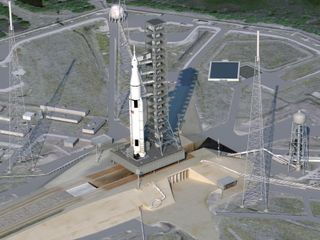
Throughout the history of human spaceflight, NASA and other space agencies have built some serious rockets: behemoths of space that aimed to send astronauts to the moon, Mars or elsewhere in deep space.
Take a look at some of the tallest rockets in history, and NASA's latest entry: the Space Launch System to fly in 2017.
This countdown was originally posted in September 2011. It was updated on Dec. 9, 2018.
NASA's Mighty Saturn V
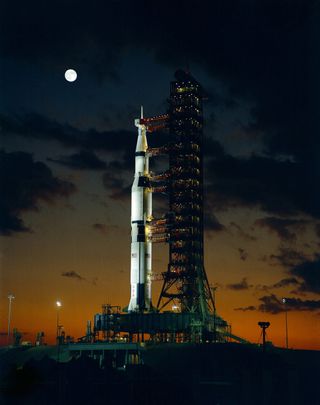
The reigning champion of giant rockets is NASA's massive Saturn V, a three-stage booster used to launch American astronauts to the moon in the late 1960s and early 1970s.
Like the Ares I-X and NASA shuttles, the towering Saturn V launched from the Kennedy Space Center in Florida. It stood 363 feet (110 meters) high and remains the most powerful rocket ever built, even though the last one flew in 1973.
The rocket could launch payloads of up to 45 tons to the moon, or 120 tons into Earth orbit. It weighed 6.5 million pounds (3 million kg) fully fueled at liftoff. The Ares I-X weighs 1.8 million pounds (816,466 kg), slightly less than the full Ares I rocket.
That last Saturn V was a modified version that launched NASA's Skylab space station. Smaller versions of the Saturn rocket were used to launch astronauts to Skylab, with the last one — a 224-foot (68-meter) Saturn 1B — launching in 1975 to fly Apollo astronauts to meet a Soviet Soyuz spacecraft during the Apollo-Soyuz joint mission.
Ill-fated N-1
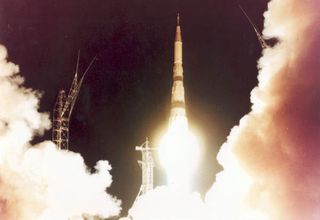
A close second in the giant rocket race is the former Soviet Union's N-1 rocket, an enormous booster designed to launch cosmonauts to the moon during the Space Race with the United States.
The giant rocket stood nearly 345 feet (104 meters) tall, had five distinct stages and resembled a huge, tapering cone that was about 55 feet (17 meters) wide at the base. During launch, it weighed 6.1 million pounds (2.7 million kg) and was envisioned to launch payloads of up to 95 tons to space to send cosmonauts to the moon, according to the Russian space history website Russianspaceweb.com. [Infographic: Moscow's Secret Moon Plan - The N-1 Rocket]
But the N-1 rocket never successfully reached space, despite four attempted launches. It exploded during all four attempts between 1969 and 1972.
The former Soviet Union did have other hefty rockets in its space launch inventory: the enormous D-1E and D-1 variants of the Proton used for the 1968 lunar probe missions and 1971 Salyut 1 space station launch. Neither came close to the N-1's towering stature.
Today, Russia still uses Proton rockets and smaller Soyuz boosters to launch satellites into orbit, though cosmonauts continue to ride only Soyuz rockets into orbit. The country is also developing a new family of Angara rockets.
SpaceX Falcon Heavy
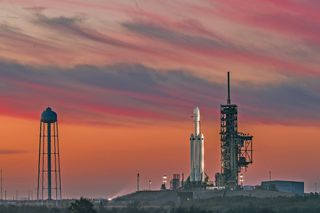
SpaceX's Falcon Heavy rocket may not be the tallest rocket in use today, but at 230 feet (70 meters) it's pretty close.
And while it's not the tallest of the bunch, the Falcon Heavy rocket is currently the most powerful booster of the 21st century. It can launch payloads of up to 141,000 lbs. (64 metric tons) using two side boosters based on the company's Falcon 9 workhorse and a central core. That gives the Falcon Heavy 27 engines on its first stage to generate more than 5 million pounds force (22,819 kilonewtons) of thrust at liftoff — the same force as about 18 Boeing 747 jumbo jets at full power.
One bonus to the Falcon Heavy: It's designed to be partially reusable. SpaceX built the first-stage boosters to return to Earth for land or drone ship landings.
Delta IV Heavy

The tallest 21st century rocket in regular service in the United States currently is the Delta IV Heavy, a heavy-lift version of the United Launch Alliance's Delta 4 booster.
Standing 235 feet (72 meters) tall, the Delta 4 Heavy made its launch debut in 2004, but suffered a sensor glitch that prevented it from reaching its intended orbit. The problem was promptly fixed. The rocket most recently launched a classified satellite for the National Reconnaissance Office in January.
The Delta 4 Heavy is actually a group of three boosters, each called a Common Booster Core, arranged in a line to give it a three-column look. At least two more Delta 4 Heavy missions are expected on the books for future classified satellite launches, according to Spaceflight Now.
The rocket is capable of launching payloads of up to 24 tons to low-Earth orbit and 11 tons toward the geosynchronous orbits used by communications satellites, according to Spaceflight Now. The Delta 4 Heavy is also touted to be able to launch 11-ton payloads on trans-lunar injection orbit routes toward the moon and 8.8-ton payloads on Mars-bound trajectories, Spaceflight Now has reported.
NASA's Ares 1 Rocket/Liberty Booster

In 2009, NASA launched what remains the tallest rocket to launch in the 21st century so far: the Ares 1 rocket on the Ares 1-X test flight. The rocket launched in October 2009 on a mission to test NASA's rocket design to launch its Orion crew capsule on moon missions for the now-scrapped Constellation program. The Ares 1 rocket stood 327 feet (100 meters) high — 14 stories taller than NASA's space shuttles. But the 2009 flight was the only trip for the Ares 1 design. President Barack Obama canceled NASA's moon-oriented Constellation program in 2010 and replaced it with a new plan aimed at deep space missions to asteroids and Mars.
The first stage of the Ares 1 rocket was built by shuttle solid rocket booster builder ATK, which has since repurposed the design for its new commercial rocket: the Liberty booster.
NASA's Space Launch System

NASA's latest giant rocket is the Space Launch System (SLS), which is designed to launch the agency's Orion space capsule — a vehicle originally drawn up as part of NASA's now cancelled Constellation program for deep space exploration.
NASA officials say the SLS will be a Saturn V-class rocket that can also be used to launch cargo, equipment and science experiments to Earth's orbit and destinations beyond. It could also serve as a backup booster for trips to low-Earth orbit, the agency says.
According to NASA, the SLS will have an initial lift capacity of 70 metric tons and stand about 322 feet (98 meters) tall, making it a bit shorter than the Saturn V. It will be expandable to 130 metric tons. The first developmental flight, or mission, is targeted for mid-2020.
Comparison: NASA's Space Shuttle Stack
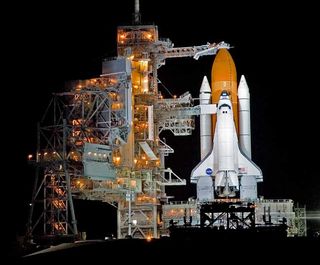
NASA's space shuttle fleet may seem puny compared to giant rockets of the past, but its 30-year flight history makes it a good measuring stick when it comes to booster match-ups. And, of course, it depends how you measure the shuttles.
On the ground, each NASA space shuttle — there are three in museums today: Discovery, Atlantis and Endeavour — is about 122 feet (37 meters) long from nose to stern and stands 56 feet (17 meters) tall. They have a wingspan of about 78 feet (23 meters).
But in launch position, the orbiter was perched on the side of its 15-story external fuel tank and flanked by two solid rocket boosters. A shuttle on the launch pad measured 184 feet (56 meters) tall from the tip of the external tank down to the aft skirts of its twin solid rocket boosters.
The space shuttle had a 60-foot (18 meter) long payload bay that is 15 feet (4.5 meters) wide. Orbiters could haul large payloads into orbit, making the shuttle the only spacecraft capable of launching massive segments of the International Space Station, which occupied the bulk of the shuttle fleet's flight manifest for more than a decade.
NASA launched 135 shuttle missions since the fleet's debut flight made by Columbia in April 1981. There were two failures: The shuttle Challenger and seven astronauts were lost just after launch in January 1986 due to an O-ring seal leak in a solid rocket booster that led to an explosion. The shuttle Columbia broke apart during re-entry in February 2003 due wing heat shield damage. Seven astronauts were killed.
After each accident, NASA stood down from shuttle flights to make safety improvements.
NASA retired its space shuttle fleet in 2011 with the final flight of Atlantis on the STS-135 mission.
Join our Space Forums to keep talking space on the latest missions, night sky and more! And if you have a news tip, correction or comment, let us know at: community@space.com.
Get the Space.com Newsletter
Breaking space news, the latest updates on rocket launches, skywatching events and more!

Tariq is the Editor-in-Chief of Space.com and joined the team in 2001, first as an intern and staff writer, and later as an editor. He covers human spaceflight, exploration and space science, as well as skywatching and entertainment. He became Space.com's Managing Editor in 2009 and Editor-in-Chief in 2019. Before joining Space.com, Tariq was a staff reporter for The Los Angeles Times covering education and city beats in La Habra, Fullerton and Huntington Beach. In October 2022, Tariq received the Harry Kolcum Award for excellence in space reporting from the National Space Club Florida Committee. He is also an Eagle Scout (yes, he has the Space Exploration merit badge) and went to Space Camp four times as a kid and a fifth time as an adult. He has journalism degrees from the University of Southern California and New York University. You can find Tariq at Space.com and as the co-host to the This Week In Space podcast with space historian Rod Pyle on the TWiT network. To see his latest project, you can follow Tariq on Twitter @tariqjmalik.
